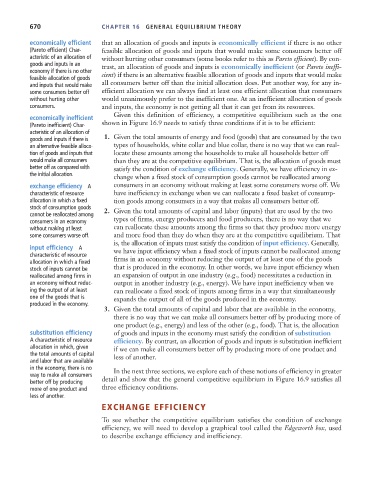Page 696 - Microeconomics, Fourth Edition
P. 696
c16GeneralEquilibriumTheory.qxd 8/16/10 9:13 PM Page 670
670 CHAPTER 16 GENERAL EQUILIBRIUM THEORY
economically efficient that an allocation of goods and inputs is economically efficient if there is no other
(Pareto efficient) Char- feasible allocation of goods and inputs that would make some consumers better off
acteristic of an allocation of without hurting other consumers (some books refer to this as Pareto efficient). By con-
goods and inputs in an trast, an allocation of goods and inputs is economically inefficient (or Pareto ineffi-
economy if there is no other cient) if there is an alternative feasible allocation of goods and inputs that would make
feasible allocation of goods
and inputs that would make all consumers better off than the initial allocation does. Put another way, for any in-
some consumers better off efficient allocation we can always find at least one efficient allocation that consumers
without hurting other would unanimously prefer to the inefficient one. At an inefficient allocation of goods
consumers. and inputs, the economy is not getting all that it can get from its resources.
Given this definition of efficiency, a competitive equilibrium such as the one
economically inefficient
(Pareto inefficient) Char- shown in Figure 16.9 needs to satisfy three conditions if it is to be efficient:
acteristic of an allocation of
goods and inputs if there is 1. Given the total amounts of energy and food (goods) that are consumed by the two
an alternative feasible alloca- types of households, white collar and blue collar, there is no way that we can real-
tion of goods and inputs that locate these amounts among the households to make all households better off
would make all consumers than they are at the competitive equilibrium. That is, the allocation of goods must
better off as compared with satisfy the condition of exchange efficiency. Generally, we have efficiency in ex-
the initial allocation. change when a fixed stock of consumption goods cannot be reallocated among
exchange efficiency A consumers in an economy without making at least some consumers worse off. We
characteristic of resource have inefficiency in exchange when we can reallocate a fixed basket of consump-
allocation in which a fixed tion goods among consumers in a way that makes all consumers better off.
stock of consumption goods 2. Given the total amounts of capital and labor (inputs) that are used by the two
cannot be reallocated among
consumers in an economy types of firms, energy producers and food producers, there is no way that we
without making at least can reallocate these amounts among the firms so that they produce more energy
some consumers worse off. and more food than they do when they are at the competitive equilibrium. That
is, the allocation of inputs must satisfy the condition of input efficiency. Generally,
input efficiency A we have input efficiency when a fixed stock of inputs cannot be reallocated among
characteristic of resource
allocation in which a fixed firms in an economy without reducing the output of at least one of the goods
stock of inputs cannot be that is produced in the economy. In other words, we have input efficiency when
reallocated among firms in an expansion of output in one industry (e.g., food) necessitates a reduction in
an economy without reduc- output in another industry (e.g., energy). We have input inefficiency when we
ing the output of at least can reallocate a fixed stock of inputs among firms in a way that simultaneously
one of the goods that is expands the output of all of the goods produced in the economy.
produced in the economy.
3. Given the total amounts of capital and labor that are available in the economy,
there is no way that we can make all consumers better off by producing more of
one product (e.g., energy) and less of the other (e.g., food). That is, the allocation
substitution efficiency of goods and inputs in the economy must satisfy the condition of substitution
A characteristic of resource efficiency. By contrast, an allocation of goods and inputs is substitution inefficient
allocation in which, given if we can make all consumers better off by producing more of one product and
the total amounts of capital less of another.
and labor that are available
in the economy, there is no In the next three sections, we explore each of these notions of efficiency in greater
way to make all consumers
better off by producing detail and show that the general competitive equilibrium in Figure 16.9 satisfies all
more of one product and three efficiency conditions.
less of another.
EXCHANGE EFFICIENCY
To see whether the competitive equilibrium satisfies the condition of exchange
efficiency, we will need to develop a graphical tool called the Edgeworth box, used
to describe exchange efficiency and inefficiency.

